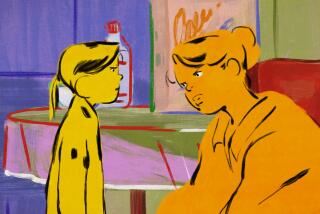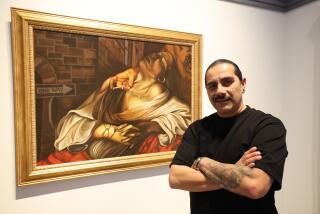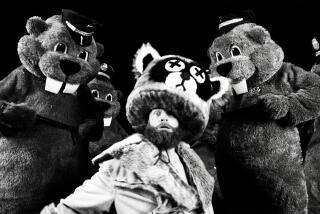Adventures on Tintin’s home turf in Brussels

Director Steven Spielberg’s “The Adventures of Tintin” starts innocently enough — with Tintin, it always does — at a flea market, where the dauntless boy reporter finds an old model boat. But blistering barnacles! — as his buddy Capt. Haddock would say — there’s a secret inside about a long-lost pirate treasure. So Tintin sets out to find it, undeterred by goons with guns, crashes, explosions, cracks on the skull from behind.
Hold it. Rewind. That flea market? I think I’ve seen it before.
Of course I have. I’ve been to Brussels, lifelong home of Tintin’s creator, Georges Prosper Remi, better known by his comic book nom de plume, Hergé. Fans and scholars of the strip — a serious tribe known as Tintinologists — may recall an often-reproduced photo of Hergé, posed with a natty cane and bowler hat at the market on the Place du Jeu de Balle in the funky-chic Marolles district of Brussels, where collectors sell vintage postcards, dubious Old Master paintings, threadbare Oriental rugs, broken lamps and model ships just like the one Tintin finds at the opening of the film. On a Sunday morning, the Jeu de Balle flea market is one of my favorite places because of its Tintin connections.
Tintin is everywhere in the Belgian capital, a national hero bigger than Jacques Brel, René Magritte, even moules-frites. You can’t buy a paper without seeing the bland, round mug of Hergé’s alter ego on stacks of cartoon books at newsstands. Neuhaus chocolate shops feature Tintin gift tins, and there’s a Tintin boutique just off the Grand-Place downtown.
Cartoons by Hergé and other Belgian artists are a cherished part of the culture in dour, gray, buttoned-up Brussels, the way the city smiles out from under its umbrella. An official Comic Strip Trail, created by the Brussels Tourist Office, takes aficionados past 30 murals of famous Belgian cartoon characters, including Tintin and Haddock climbing a fire escape on the side of a house, to the Comic Strip Center in an elegant Art Nouveau building downtown, and to the smashing new Hergé Museum about 20 miles south of town, where no clue about the artist and his oeuvre is left unexamined.
I’m no Tintinologist, but I have my own Tintin tour of Brussels, which starts by arriving at the South Station (Gare du Midi) on a high-speed Thalys train. Spielberg, who was in town for the Oct. 23 European premiere of “The Adventures of Tintin,” went to the station for the inauguration of Thalys trains emblazoned with characters from the strip.
At one entrance, visitors are welcomed by a huge black-and-white mural of the cartoon hero clinging to the side of a speeding locomotive, a frame from “Tintin in America.” He has myriad connections to trains (as well as every other kind of high-velocity conveyance). In 1935, Hergé designed an advertising brochure for the Belgian Railways, and when he completed Tintin’s first two adventures, his publisher staged welcome-home celebrations for the boy reporter at the Gare du Midi, starring a Tintin impersonator.
Hergé was a steady, middle-class lad of 22, scribbling in margins while working for the subscriptions department of a Belgian newspaper, when his artistic talents were discovered, leading to the 1929 publication of his first strip, “Tintin in the Land of the Soviets.” It was an immediate sensation, equally fascinating to children and grown-ups.
“I am Tintin,” Hergé once said. “I am no hero. But like all 15-year-old boys, I have dreamed about being one. And I never stopped dreaming.”
A second serial adventure followed in 1930, taking Tintin to the Belgian Congo, every frame imbued with racist clichés and paternalistic arrogance common at the height of the colonial era. Hergé later apologized for portraying Africans as “great big children,” but kids in the Congo loved it, and Tintin went on to conquer the world, eventually racking up sales of 250 million books, translated into 100 languages.
The strip failed to catch on only in the U.S., which has its own indigenous comic book tradition featuring superheroes instead of curious adolescent boys. In 1948, Disney turned down an overture from Hergé, presumably because most Americans had never heard of Tintin.
Spielberg, who got to know him as an adult, told Le Monde magazine, “I am not Tintin. I’m more like Snowy,” evincing a fondness for the boy reporter’s faithful white fox terrier pup, whose dueling angels and demons make him the most human (and my favorite) character in the strip.
The director had just completed his first Indiana Jones movie, “Raiders of the Lost Ark,” when he put in a call to Hergé. A meeting was arranged, but the 75-year-old artist, suffering from leukemia, died before they could get together in the spring of 1983. After that, the movie project hung fire for almost 20 years, until Spielberg discovered motion capture and enlisted fellow filmmaker Peter Jackson, who’d used the computer-assisted film technique in the “Lord of the Rings” trilogy.
Motion capture would have fascinated Hergé, a self-taught artist who spent his life at the drafting board where two dozen Tintin adventures meticulously came to life, each one more technically accomplished and deeply researched than the last. Between 1929 and 1983, he worked in studios all around Brussels, eventually hiring a design team to help with the strip, though he never loosened the reins, stipulating that it could not continue after his death.
None of his workshops is marked or open to visitors. But near the Gare du Midi, Hergé fans can look up to see the iconic neon sign depicting Tintin and Snowy atop a building on Avenue Paul-Henri Spaak where Hergé and his publisher, Editions du Lombard, launched Tintin magazine after World War II.
Hergé had spent the war years drawing three of his best strips — “The Crab With the Golden Claws,” “The Secret of the Unicorn” and “Red Rackham’s Treasure” — for Le Soir, a widely circulated newspaper run by Nazis during the German occupation of Belgium. Afterward, the artist maintained that Tintin had raised Belgian spirits, but the collaborationist taint made him succumb to depression and consider moving to Argentina.
That and an extramarital romance with a beautiful young colleague who became his second wife seem to have been the only storms in an otherwise uneventful life. But Tintinologists keep searching for clues about the psychological makeup of a man whose head resounded with the voices of 228 zany characters: the mad scientist-inventor Professor Calculus, yowling opera singer Bianca Castafiore (Hergé hated opera), Nestor the butler and Tintin’s Chinese friend Chang. My favorite place to see them is at the Stockel Metro stop in eastern Brussels, where 140 life-size figures, designed by Hergé shortly before his death, parade on both sides of the platform.
Look! There are Thomson and Thompson, the bumbling detectives who provide comic relief in almost every adventure. Their matching bowler hats have been interpreted as a clue by Tintinologists, because Hergé’s father and uncle, like the gumshoes, were twins who always wore bowlers. The Remi brothers were born out of wedlock to a chambermaid in a château, later married off to the gardener. In Brussels, it’s still rumored that their real father was King Leopold II, inspiring the character of Capt. Haddock, whose ancestor was the bastard son of King Louis XIV of France.
For the rest of the back story, told in delightful detail, I visited the Hergé Museum on a trip to Brussels last spring. The building, designed by Pritzker Prize-winning architect Christian de Portzamparc, opened in 2009 in Louvain-la-Neuve. Its two elevated, block-shaped wings are decorated with a giant, full-color frame from the Tintin strip.
A causeway leads inside where visitors claim audio tours or cellphone apps — available in English — to guide them through displays on seemingly every aspect of the artist’s life and work, from his creation of Totor, a proto-Tintin, for a Boy Scout magazine in the 1920s, to his midlife crisis in the late 1950s, marked by nightmares in white that inspired the snowy Himalayan backgrounds of “Tintin in Tibet.”
Even casual visitors come away with a heightened appreciation of Hergé’s style, known as ligne claire, or clear line, for its bold delineation and comic book innovations, including refinement of the speech bubble and cliff-hanger. I learned, as well, about film and TV adaptations of the strip that came before the new motion-capture movie, none of them wholly pleasing to Hergé, who near the end of his life told a biographer that Spielberg was the only director capable of bringing Tintin to the screen.
Other exhibits study the sources for Hergé’s plots, often drawn from the news of the day, and his penchant for deep research that gives plausibility to adventures that took the hero to the ocean bottom in a submarine and landed him on the moon in a space capsule 16 years before Apollo 11.
But Blundering Bazookas! It turns out Hergé preferred cats to dogs. Obviously, he never met one like Snowy.
More to Read
Sign up for The Wild
We’ll help you find the best places to hike, bike and run, as well as the perfect silent spots for meditation and yoga.
You may occasionally receive promotional content from the Los Angeles Times.






